



Added 12 January 2017
Saturday, 28 March 2015, Arizona Trail Passage 15: Tortilla Mountains - Freeman Road to Kelvin Bridge
At 28.4 miles long, Passage 15 is a fairly long passage, and is one without particularly reliable or good water sources. To keep from carrying two days worth of water, and with road access to the middle of the passage, we decided to do this passage by day hiking it on two consecutive days, camping out at the mid-point in between days. So yesterday, we drove three cars out to the area. We met where the Florence-Kelvin Highway (don't be fooled, it's a dirt road) meets Tecolote Ranch Road. Since Tecolote Ranch Road is not passenger car friendly we left my car there. I loaded my gear into Jerry's truck and we took that and Shaun's truck to a point where the road intersects the Arizona Trail, roughly halfway through Passage 15.
Jerry and Cheetah were up and getting ready for the day at four o'clock this morning. No thank you!! Not needing as much time to get ready to go, I continued dozing off and on until closer to five o'clock before getting out of bed. The instant I pulled my boots out of my duffel bag, the realization hit me that the previous weekend I had taken my gel insoles out of my hiking boots and put them into the work boots I use for my invasive species removal volunteer work. I never put them back in my hiking boots. Just to be certain, I did some quick sole searching, but my initial fear was accurate. I was a forgotten soul who forgot insoles. And this is how Passage 15 became the first passage to have earned itself a title . . .
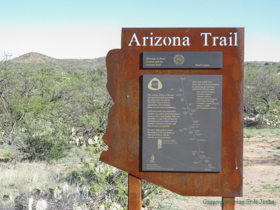
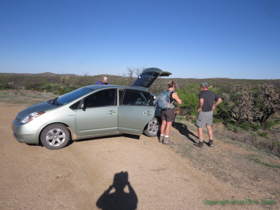 No one in the group wears my shoe size, meaning I would have to hike over 26 miles in boots without any insole whatsoever. I tried to think of something in my gear that I could put in my boots that would mimic the effect of insoles, but failed.
No one in the group wears my shoe size, meaning I would have to hike over 26 miles in boots without any insole whatsoever. I tried to think of something in my gear that I could put in my boots that would mimic the effect of insoles, but failed. 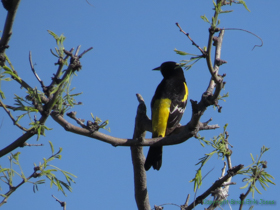 My only solution was to wear both pairs of socks that I had packed in order to consume some of the boot volume that would have been taken up by the insoles. I already have foot pain issues, so I dreaded what 26 plus miles without insoles was going to do to my feet. After getting my boots on and taking a few steps around camp my fears were not allayed. I anticipated a lot of pain over the course of the weekend.
My only solution was to wear both pairs of socks that I had packed in order to consume some of the boot volume that would have been taken up by the insoles. I already have foot pain issues, so I dreaded what 26 plus miles without insoles was going to do to my feet. After getting my boots on and taking a few steps around camp my fears were not allayed. I anticipated a lot of pain over the course of the weekend.
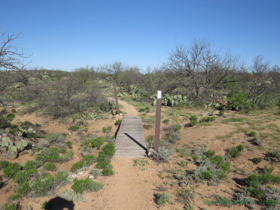 Even though I was the last one to get up, I was still the first one to be ready to go. We planned on leaving camp in Shaun's truck at 6:00 a.m. and we ended up leaving at around 6:15. Not bad. Jerry's truck we left where it was so we could have some comforts in camp tonight. Back out at the Florence-Kelvin Highway, I got in my car and we caravanned to the end of Passage 15. The Florence-Kelvin Road is a wide, well-maintained gravel road and I was whipping my little Prius along it at a pretty good clip, easily leaving Shaun in the dust. For one of the first times since I got rid of it, I really missed my truck. There is something about driving fast down dirt roads that is both exhilarating and immensely peaceful to me.
Even though I was the last one to get up, I was still the first one to be ready to go. We planned on leaving camp in Shaun's truck at 6:00 a.m. and we ended up leaving at around 6:15. Not bad. Jerry's truck we left where it was so we could have some comforts in camp tonight. Back out at the Florence-Kelvin Highway, I got in my car and we caravanned to the end of Passage 15. The Florence-Kelvin Road is a wide, well-maintained gravel road and I was whipping my little Prius along it at a pretty good clip, easily leaving Shaun in the dust. For one of the first times since I got rid of it, I really missed my truck. There is something about driving fast down dirt roads that is both exhilarating and immensely peaceful to me.
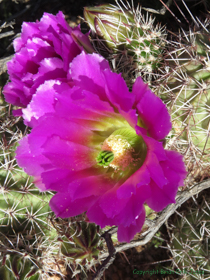
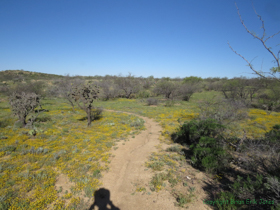 We left Shaun's truck at the end of Passage 15 and 5 people people and 2 dogs piled into my now crowded little car. Taking the paved route around through Kelvin and Winkelman, we drove to the Passage 15 trailhead at Freeman Road. The whole shuttle took almost exactly two hours from the time we left camp. By 8:45, we were hiking. The day started off really well, as not 15 seconds into the hike I saw a male Scott's Oriole singing his heart out and looking fabulous at the top of a Palo Verde tree.
We left Shaun's truck at the end of Passage 15 and 5 people people and 2 dogs piled into my now crowded little car. Taking the paved route around through Kelvin and Winkelman, we drove to the Passage 15 trailhead at Freeman Road. The whole shuttle took almost exactly two hours from the time we left camp. By 8:45, we were hiking. The day started off really well, as not 15 seconds into the hike I saw a male Scott's Oriole singing his heart out and looking fabulous at the top of a Palo Verde tree.
To be perfectly honest, when we started out I wasn't particularly impressed with the scenery of Passage 15 and it set my expectations for at least the first half of the passage pretty low. However, not only did the scenery become more comely, the passage was surprisingly birdy. There were Brewer's Sparrows and White-crowned Sparrows everywhere, and a goodly number of other species as well. At one point, a little diligence on my part (allowing the group to hike well ahead of me) even paid off with a sighting of a Sage Thrasher, which was a lifer for me.
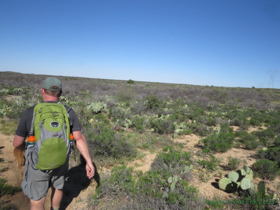
|
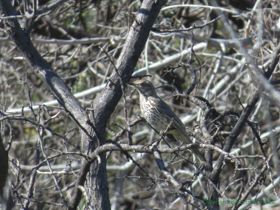
|
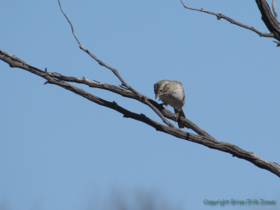
|
With all the birds, I did my typical yo-yoing off the back of the group. Lagging well behind to watch some birds, then catching up to the group just in time to stop and look at another group of birds. Even so, I didn't have time to stop and look at everything I saw, and I wonder how many more species I might have hiked right on past. I also stopped fairly frequently to admire and photograph the many species of trailside wildflowers we saw. There were few areas that were photogenically carpeted with wildflowers, but that doesn't mean they were scarce.
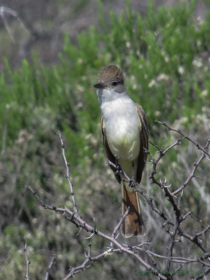
|
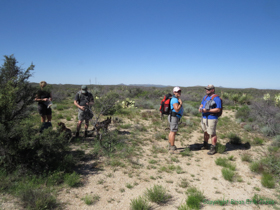
|
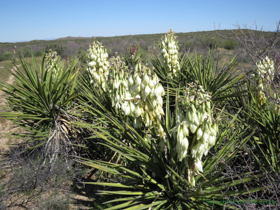
|
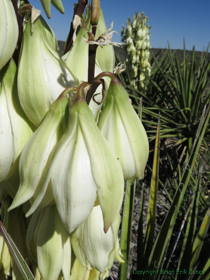
|
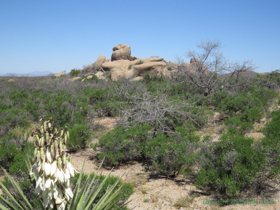
|
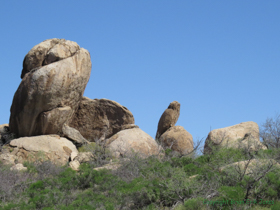
|
The trail became prettier and more interesting as we hiked, traveling through an area with very interesting sculpted granite outcrops. There wasn't much shade though, so when we reached a large rock that looked like a big monkey head we stopped under its shade for lunch.
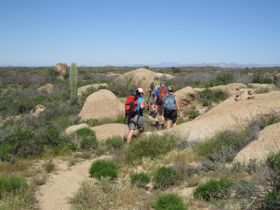
|
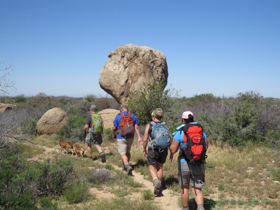
|
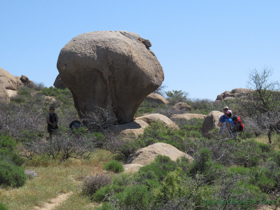
|
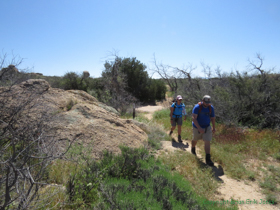
|
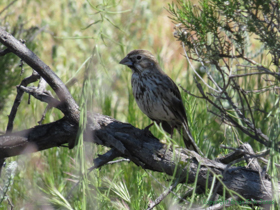
|
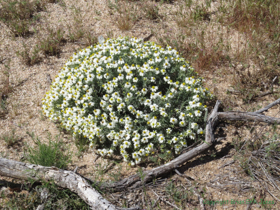
|
It was already warm when we started hiking and it only got warmer as the day progressed, but what could have been unpleasant was made bearable by a constant breeze that cooled us off.
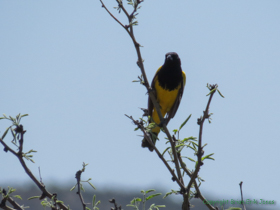
|
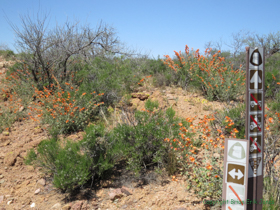
|
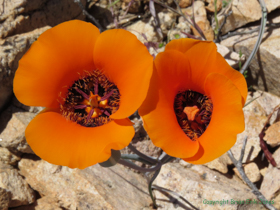
|
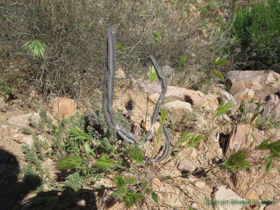
|
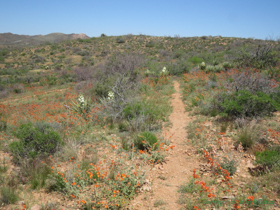
|
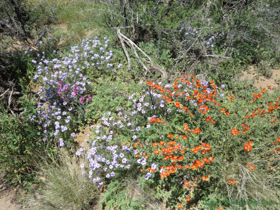
|
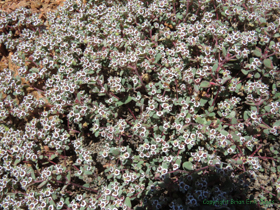
|
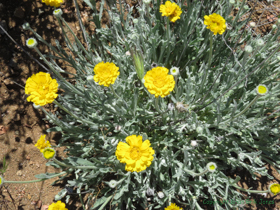
|
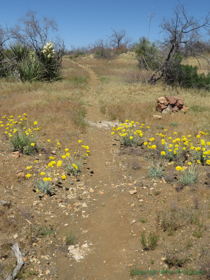
|
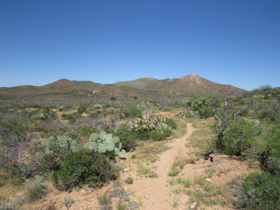
|
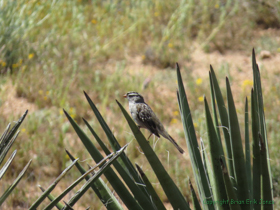
|

|
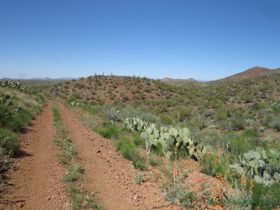 By the time I trotted into camp a little before two o'clock this afternoon, I was definitely ready for some shade and a bit of inactivity. As the day had warmed up the dogs started to go slower so Jerry and Cheetah dropped to the back of the pack and the rest of us went on. I stayed with Shaun and Raquel for a while but eventually hiked out in front. I caught up to a lone backpacker and we chatted for a little while before I left her behind me as well.
By the time I trotted into camp a little before two o'clock this afternoon, I was definitely ready for some shade and a bit of inactivity. As the day had warmed up the dogs started to go slower so Jerry and Cheetah dropped to the back of the pack and the rest of us went on. I stayed with Shaun and Raquel for a while but eventually hiked out in front. I caught up to a lone backpacker and we chatted for a little while before I left her behind me as well.
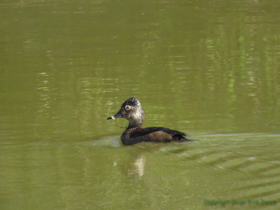
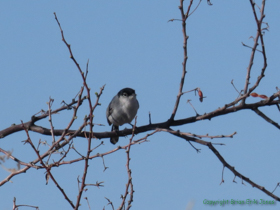 We were camped at mile 13.5 of Passage 15. I have to say, after 13.5 miles of hiking in boots without insoles, my feet didn't feel too bad. I certainly expected worse, and have experienced worse even with insoles.
We were camped at mile 13.5 of Passage 15. I have to say, after 13.5 miles of hiking in boots without insoles, my feet didn't feel too bad. I certainly expected worse, and have experienced worse even with insoles.
At camp, I moved my chair into the shade of the truck to await the arrival of the rest of the crew. Shaun and Raquel strolled in about 10 minutes later, and Jerry and Cheetah arrived another 15 minutes after that. With them came the truck keys and access to cold drinks. Huzzah! Everyone was content to more or less just sit around in the shade and relax the afternoon away. I was tempted myself, but after an hour and a half of just hanging out, a bird flew over that I couldn't identify and I was reminded that there was stuff out in the world to see, so I grabbed my binoculars and my pack and headed out. My plan was to wander around the stock tank on the other side of the road, then maybe wander up the wash a bit until I found a nice shade tree to sit under and let the birds come to me. And that's exactly what I did!
For about 10 minutes. I lay in the shade just relaxing and waiting for the birds when my plan worked too well. I heard a pair of birds who's songs were totally unknown to me. Great. Now I was forced to get up and investigate, and it was all uphill from there. I figured out that the calling birds were Bell's Vireos. And they led me to some Black-tailed Gnatcatchers, and they led me to a pair of mating Northern Flickers. You get the picture. It was then that I happened to glance down and see a Gila Monster crossing the wash not 25 feet from me! He was obliging and stopped briefly to let me check him out and get some pictures before he scurried off into some dense vegetation.
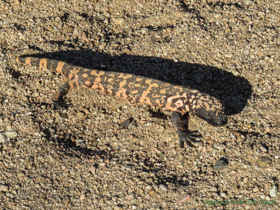
|
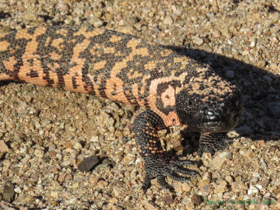
|
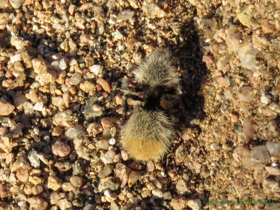
|
Now there was no chance for my original plan. No wiling away the afternoon under a tree for me. After going back to collect my things, I was on my feet until the last light of day was gone. I wandered east up a road into the foothills of the Tortilla Mountains until the sun hit the horizon. I saw about 20 species on the AZT today, and saw more than 20 species (some the same as on the AZT) on my evening ramble. All told, I saw more than 30 species on the day.
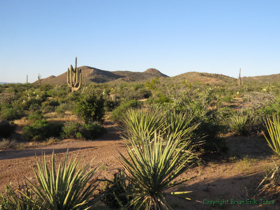
|
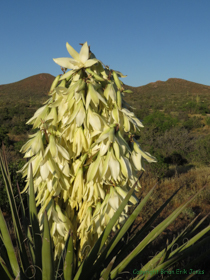
|
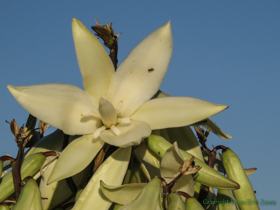
|

|
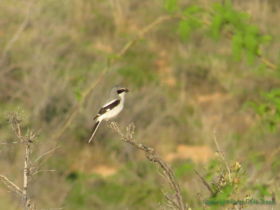
|
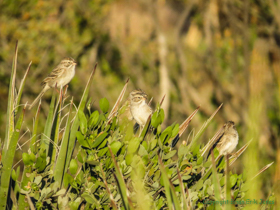
|
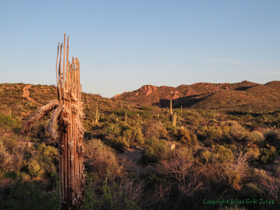
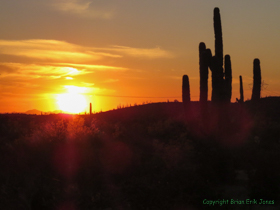 I then hustled back to camp. When I got to camp, Jerry was already brushing his teeth. Everyone had eaten and were getting ready to go to bed. They hung out with me while I prepared and ate dinner then turned in for the night. I too went to my tent, but it was a little too early for me to fall asleep, despite the early start this morning, so I read a little bit before calling it a day.
I then hustled back to camp. When I got to camp, Jerry was already brushing his teeth. Everyone had eaten and were getting ready to go to bed. They hung out with me while I prepared and ate dinner then turned in for the night. I too went to my tent, but it was a little too early for me to fall asleep, despite the early start this morning, so I read a little bit before calling it a day.
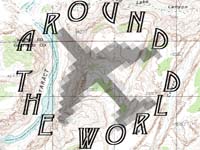 |
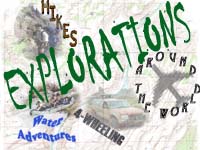 |